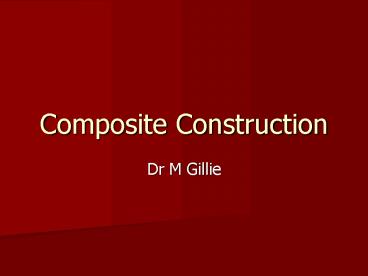Composite Construction - PowerPoint PPT Presentation
1 / 18
Title:
Composite Construction
Description:
Slimflor, SlimDeck Consist of several elements Profiled metal deck Concrete with mesh/reinforcement Steel beams Columns Two stages to design Construction ... – PowerPoint PPT presentation
Number of Views:441
Avg rating:3.0/5.0
Title: Composite Construction
1
Composite Construction
- Dr M Gillie
2
Composite Floors
- Connection between steel and concrete
- Bending strength greatly enhanced (c50)
- Stiffness much great. Can govern design
- Material working much closer to yield strength
3
Typical Floor System
4
Composite Systems
- Highly optimised
- Can be proprietary eg. Slimflor, SlimDeck
- Consist of several elements
- Profiled metal deck
- Concrete with mesh/reinforcement
- Steel beams
- Columns
- Two stages to design
- Construction (non-composite)
- Final (composite)
5
(No Transcript)
6
Typical Floor Arrangement
Concrete floor
Profiled metal deck
Steel I-section
Mesh reinforcement
7
Typical Composite System
c6-10m (cellular beams longer)
Composite primary beams span between columns
Floor slab spans between secondary beams
c3m
Composite secondary beams span between
primary beams (or columns)
8
How the Floor Works
c6-10m (cellular beams longer)
Floor slab spans between secondary beams
c3m
9
How the Floor Works
Profiled concrete slab spans between beams
I-sections
c 3m
Ribs run left to right in slab Assume
simply-supported over beams
Fc
x1
Concrete in compression
x2
Fs
MuFc(x1/2x2)
Steel in tension
Steel deck acts as tension reinforcement
Mesh mainly to prevent cracking
10
Typical Floor System
c6-10m (cellular beams longer)
c3m
Composite secondary beams span between
primary beams (or columns)
11
How the Secondary Beams Work
Shear studs
Profiled concrete slab
Design as simply Supported (conservative)
Steel-decking not acting
Steel I-section
12
How the Secondary Beams Work
Assume UDL
Compression in concrete
Zero forces at ends
Tension in steel
- Zero force at ends
- Largest force at point of peak moment
- Therefore shear studs must transfer forces
- Shear flow governs how much force is
transferred at each point
13
Simple view of Composite Capacity
b
Fc
sc
h
D
Fs
ss
Forces
Section in ultimate bending state
Taking moments about line of Fc gives
MultFs(Dh)/2
- This assumes
- Steel capacity sufficient to resist concrete web
force - Full shear connection
- Ignores profiles in decking
14
Composite Capacity Effective Width
b
b
b
beff
beff
beff
- Effective width depends on
- Loading
- Point within span
- Support conditions
- Empirical guidance in design codes
- Obviously beffltb
15
Effect of Effective Width
b
Fc
- Large effective width
- NA in concrete
- Common in secondary beams
sc
ss
Fs
b
Fc
sc
- Small effective width
- NA in steel (web or flange)
- Common in primary beams
Fs1
Fs2
ss
b
Fc
sc
- Simplest case
- NA at interface
ss
Fs
16
Shear Flow (simple elastic)
w
Fc
Consider cut through a composite beam at
position x
d
Fs
0
wL/2
x
Moments about 0
17
How the Secondary Beams Work (heavily loaded)
Studs deform
Plastic condition, high load (all studs take
equal load except middle one)
Shear flow or force in studs
Elastic condition, low load (varying load in
studs)
18
Composite Capacity Partial Shear Connection
w
Fc
d
Ft1
Ft3
Ft2
Fs
0
wL/2
x
If Ft1 Ft2 Ft3ltFc then partial shear
connection This means total force in concrete
can not be transferred by shear studs to
steel Quite common due to no room for enough
studs Not a problem in practice.































